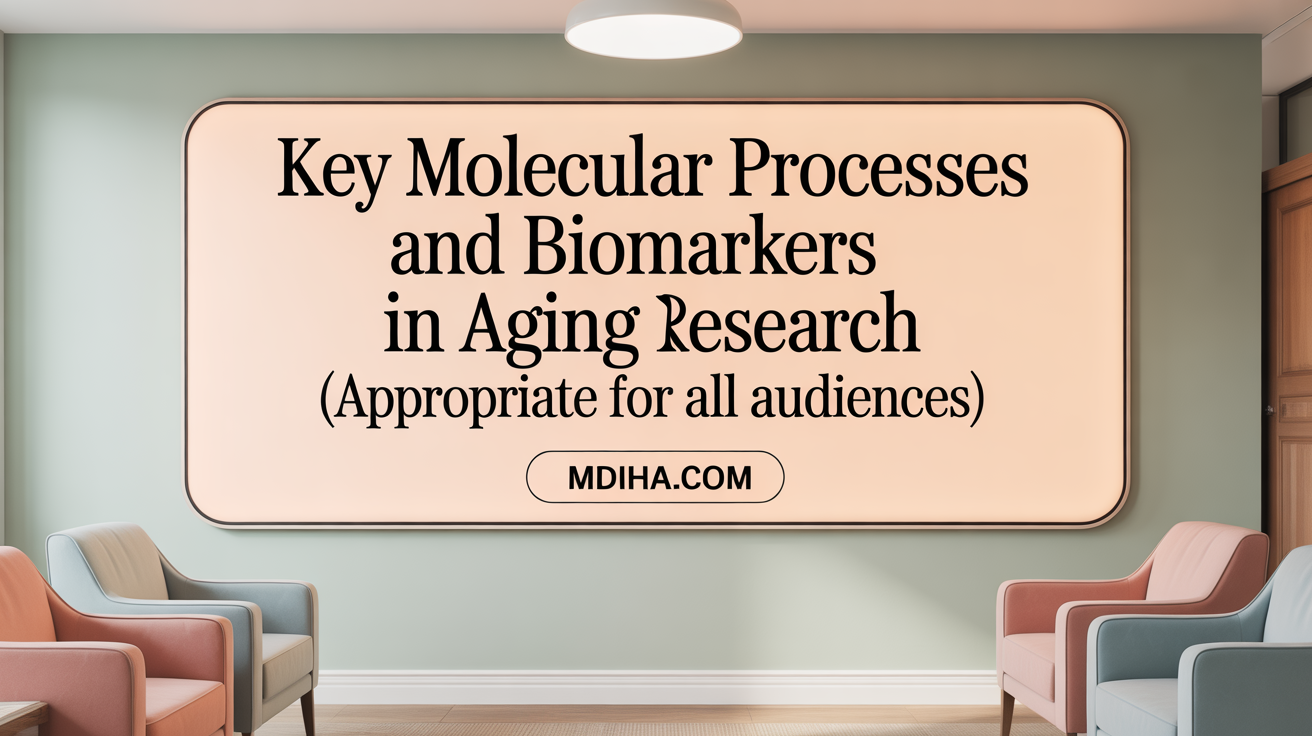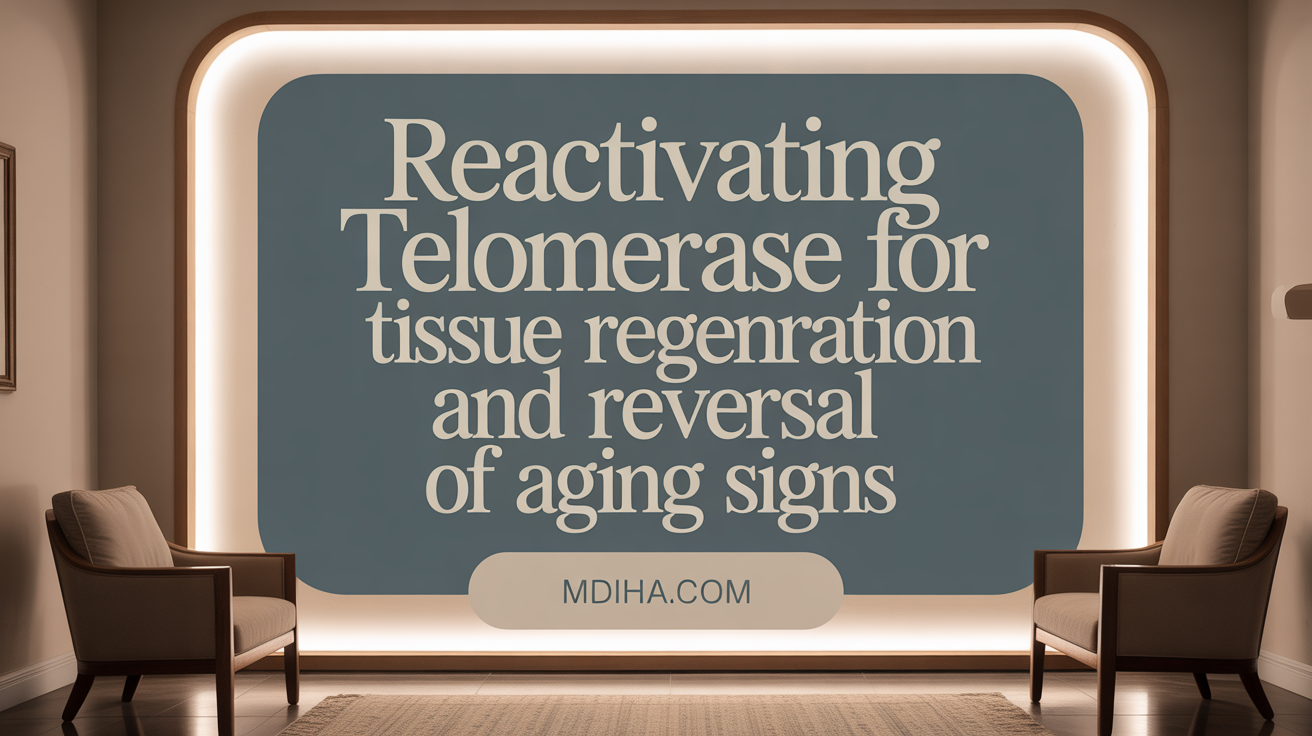Unlocking the Secrets of Aging Through Science
As the global population ages, scientific innovation has taken center stage in transforming our understanding of aging and healthspan. The Miami Institute on Human Aging (MIHA) is at the forefront of this revolution, leveraging cutting-edge research and emerging technologies to redefine what it means to age. This article explores how MIHA integrates molecular biology, gene reactivation, chemical reprogramming, and advanced biomarker technologies to scientifically address aging, aiming not just to extend lifespan but to enhance vitality and function throughout life.
The Scientific Foundations of Aging: From Cells to Systems

What is the scientific process of aging?
The scientific understanding of aging involves examining how our bodies gradually lose their ability to maintain optimal health and function over time. This process is driven by complex cellular and molecular changes that accumulate throughout life.
One key aspect of aging is cellular senescence, where cells reach their limit of division, often due to the shortening of telomeres—protective caps at chromosome ends. As telomeres become too short, cells enter a state where they no longer divide, but they also release substances that lead to tissue damage and inflammation.
In addition to cellular limits, oxidative damage plays a significant role. Free radicals generated by cellular metabolism can damage DNA, proteins, and lipids. This damage accumulates over time, contributing to the decline in cellular function and promoting aging-related changes.
Research suggests that lifestyle choices, such as diet, exercise, and sun protection, can influence the rate of cellular aging. Interventions that target these molecular processes hold promise for slowing down aging and extending healthspan.
What cellular and molecular changes occur in aging?
Throughout life, cells undergo molecular damage and functional deterioration. These changes include DNA mutations, disrupted gene expression, impaired protein function, and metabolic shifts.
A prominent molecular feature of aging is the shortening of telomeres. As cells divide repeatedly, telomeres progressively shorten, eventually triggering senescence or apoptosis (programmed cell death). This loss of cellular renewal capacity results in tissue weakening and organ decline.
Alongside telomere attrition, oxidative stress causes accumulation of damaged molecules. Over time, this leads to mitochondrial dysfunction, reduced energy production, and increased inflammation—all hallmarks of aging.
Moreover, molecular signaling pathways become deregulated, impairing cellular communication and repair mechanisms. This cascade of molecular damage underpins the physical and functional declines observed in aging tissues.
How does telomere shortening and cellular senescence contribute to aging?
Telomeres serve as biological clocks within our cells. Each time a cell divides, telomeres shorten slightly. When they reach a critical length, cells cease to divide and enter senescence, a condition associated with the secretion of harmful inflammatory factors.
Senescent cells accumulate as we age, contributing to tissue stiffness, reduced regeneration, and the development of age-related diseases. For example, telomere shortening in skin cells leads to loss of elasticity, while in brain cells, it can impair neural function.
Recent advances aim to counteract telomere shortening by reactivating telomerase, the enzyme that extends telomeres. Studies in mice have demonstrated that telomerase activation can reverse tissue damage, improve organ function, and even regenerate neurons, hinting at potential therapies for age-related decline.
What is the impact of oxidative damage and molecular decline?
Oxidative stress is a major driver of molecular decline during aging. Free radicals, produced as byproducts of cellular metabolism, can damage DNA, proteins, and lipids.
This damage leads to mutations, cellular dysfunction, and the breakdown of tissue integrity. Mitochondria, the energy-producing organelles, are particularly vulnerable, and their dysfunction results in decreased energy supply and increased oxidative stress, creating a vicious cycle.
The accumulated molecular damage can impair vital processes such as DNA repair, protein folding, and metabolic regulation. Technologies that analyze molecular markers, like epigenetic clocks, allow scientists to measure biological age and assess the effectiveness of anti-aging interventions.
Overall, understanding these cellular and molecular foundations provides a roadmap for developing therapies aimed at slowing or reversing the aging process and promoting healthier, longer lives.
Decoding Aging at the Cellular Level: Molecular Mechanisms and Biomarkers

How do scientists currently explain the aging process at the cellular level?
Scientists understand aging as a gradual process driven by the accumulation of molecular and cellular damage that the body cannot fully repair. This damage manifests through various interconnected mechanisms.
One major factor is DNA mutations and telomere shortening. Telomeres are protective caps at the ends of chromosomes that shorten with each cell division. When they become too short, cells can enter a state called senescence, losing their ability to divide and function properly.
Another critical aspect is the loss of proteostasis, which refers to the maintenance of properly folded and functional proteins in cells. As aging progresses, protein repair and clearance systems become less effective, leading to protein aggregates that impair cell function.
Mitochondrial dysfunction also plays a pivotal role. Mitochondria are the energy-producing organelles within cells. Damage to mitochondrial DNA, decreased mitochondrial biogenesis, and impaired respiratory activity result in reduced energy supply and increased production of reactive oxygen species (ROS). These ROS cause oxidative stress, damaging DNA, proteins, and lipids.
Epigenetic changes—alterations in chemical modifications to DNA and histones that regulate gene expression—are key biomarkers of aging. Changes like DNA methylation patterns, which are measurable through aging clocks, reflect the biological age of cells and tissues.
Furthermore, cells can respond to accumulated damage by entering a state called senescence, where they stop dividing but still secrete inflammatory molecules that disrupt normal tissue function.
Altogether, these processes contribute to the decline of tissue integrity, reduced regenerative capacity, and the onset of age-related diseases. Ongoing research aims to understand and eventually reverse these cellular damages, paving the way for therapies that could extend healthspan and combat age-associated illnesses.
| Mechanism | Impact | Associated Biomarkers |
|---|---|---|
| Telomere shortening | Cellular aging, senescence | Telomere length, TERT expression |
| Proteostasis loss | Protein aggregation, dysfunction | Protein aggregates, chaperone levels |
| Mitochondrial dysfunction | Reduced energy, increased ROS | Mitochondrial DNA mutations, respiration |
| Epigenetic alterations | Changes in gene expression | DNA methylation patterns, aging clocks |
By dissecting these processes, scientists aim to develop targeted interventions that can slow or reverse aging at the cellular level.
MIHA’s Pillars: Scientific Advances and Technologies Driving Anti-Aging

What scientific advances and technologies are involved in anti-aging strategies?
Recent research has showcased remarkable progress in understanding and tackling the biological processes of aging. Central to these advances are technologies like genomics, proteomics, and metabolomics, which allow scientists to measure cellular and molecular changes that occur with age.
One prominent approach involves telomerase reactivation. Telomeres are protective caps at chromosome ends that shorten over time, contributing to cellular aging. Harvard scientists demonstrated that reactivating telomerase enzymes in mice could repair tissues, extend telomeres, and reverse signs of aging. This led to improvements in brain function, fertility, and tissue regeneration, including nerve and sperm cell growth.
Cellular reprogramming is another breakthrough. Using cocktails of chemicals or genetic factors such as Yamanaka factors, researchers can revert adult cells to a more youthful state without the risks of uncontrolled growth typical in gene therapy. Methods like chemical reprogramming have shown the potential to rejuvenate cells at the molecular level, decreasing markers of biological age and restoring mitochondrial function.
Gene therapy and epigenetic interventions also play vital roles. Techniques like editing the genes that control aging-related pathways—such as the mTOR pathway or NAD+ levels—can modify cellular metabolism and improve healthspan. Moreover, drugs targeting senescent cells, known as senolytics, aim to clear damaged cells that contribute to aging and age-related diseases.
Molecular pathways like mTOR, which regulates cell growth, and NAD+ metabolism, crucial for energy production and DNA repair, are now prime targets for anti-aging strategies. Enhancing these pathways has shown to delay aging signs and improve cellular function.
Together, these scientific advances leverage cutting-edge bioengineering, molecular biology, and pharmacology to develop therapies. The goal is not just to extend lifespan but to maximize health and vitality during aging, potentially reversing some aspects of cellular decline and promoting regenerative medicine approaches.
Telomerase Reactivation: Reversing Aging Signs at the Chromosome Level

What is telomerase enzyme function?
Telomerase is an enzyme responsible for maintaining the length of telomeres—the protective caps at the ends of chromosomes. As cells divide, telomeres naturally shorten, which is associated with aging and cellular aging. Telomerase replenishes these telomeres, allowing cells to sustain their dividing potential and function.
How does telomere repair and extension work?
Telomerase works by adding repetitive DNA sequences to the telomeres, thus elongating them. This process helps repair damage caused by aging and cell division, promoting cellular longevity and tissue regeneration. Restoring telomere length is seen as a promising approach to reversing some signs of aging at the cellular level.
What recent scientific research has demonstrated reversal of aging in animal models?
Recent studies have shown promising results in mice, with scientists reversing certain aging signs. Notably, Harvard researchers employed a controlled activation of telomerase in mice, which led to tissue repair, regeneration, and the growth of new neurons. These outcomes suggest that reactivating telomerase can partially reverse age-related decline.
What are the findings regarding organ regeneration and cognitive improvements?
The activation of telomerase in mice resulted in improved growth of organs such as the brain and testes, leading to better cognitive functions and increased fertility. For example, the regeneration of olfactory nerve cells and the production of new sperm cells were observed, indicating significant tissue regeneration and functional recovery.
Is the treatment safe and does it pose cancer risks?
One of the major concerns with telomerase activation is the potential for cancer development, as unchecked cell growth can lead to tumors. However, in the studies conducted, no signs of cancer were observed in the treated mice. The activation was carefully controlled to minimize risks, offering a promising safety profile so far.
| Aspect | Details | Additional Info |
|---|---|---|
| Target enzyme | Telomerase | Extends telomeres to combat aging signals |
| Main benefits | Tissue repair, organ growth, cognitive improvement | Including neurons and reproductive cells |
| Safety concerns | Risk of cancer | Controlled activation mitigates this risk |
| Study outcomes | Reversal of aging signs, regeneration | Demonstrated in mouse models |
This cutting-edge research illustrates how manipulating telomerase activity may pave the way for regenerative medicine and anti-aging therapies, although its application in humans will require further investigation.
Chemical Reprogramming: Resetting Cellular Age Through Molecular Cocktails
How do chemical cocktails restore nuclear compartmentalization?
Recent advances have shown that specific combinations of chemicals, known as chemical cocktails, can reprogram aging cells to a more youthful state. These cocktails work by restoring nuclear compartmentalization (NCC), a process that organizes the cell's nucleus, ensuring proper gene expression and cellular function. Proper NCC is crucial for maintaining youthful cellular behavior, and its decline is a hallmark of aging. By reversing this decline, the cocktails induce rejuvenation at a molecular level.
How do chemical methods compare to Yamanaka factors?
Initially, scientists relied on Yamanaka factors—genetic tools that convert adult cells into induced pluripotent stem cells (iPSCs)—to reverse cell aging. While effective, Yamanaka methods carry risks, such as uncontrolled cell growth and tumor formation. In contrast, chemical reprogramming offers a non-genetic approach, reducing safety concerns. Using a specific set of six chemical agents, researchers have achieved cellular rejuvenation without the risks associated with gene editing, paving the way for safer therapeutic applications.
Can molecular aging markers be reversed?
Studies show that chemical reprogramming can significantly decrease aging markers in cells. For example, scientists using the 7c cocktail observed reductions in epigenetic and transcriptomic clocks—biomarkers that measure biological versus chronological age. This indicates that cellular age-related damage, including molecular modifications like DNA methylation and aberrant RNA splicing, can be reversed. These changes restore youthful gene expression profiles, making cells function better and more resilient.
What improvements occur in mitochondrial bioenergetics?
A notable feature of youthful cells is efficient mitochondrial function. After treatment with the chemical cocktails, there is evidence of enhanced mitochondrial activity, including increased membrane potential and cellular respiration. These improvements suggest that mitochondria—the cell’s energy producers—become more efficient, supporting energy-intensive processes like tissue repair and regeneration. Enhanced mitochondrial bioenergetics are a promising sign of genuine cellular rejuvenation.
What is the potential for regenerative medicine?
The ability to chemically reprogram cells to a younger state holds remarkable promise for regenerative medicine. By reversing cellular aging, these methods could enable tissue repair, organ regeneration, and treatment of age-related diseases without the risks associated with stem cell transplants. Ongoing research aims to refine these cocktails and assess safety for human use, with the hope of introducing therapies that extend healthspan and improve quality of life across various medical fields.
Senolytics and Skin Aging: Clearing Senescent Cells for Tissue Rejuvenation
How do senolytic drugs contribute to reversing signs of aging, particularly in the skin?
Senolytic drugs, like ABT-263, play a significant role in combating skin aging by targeting and removing senescent cells. These cells are damaged or aged cells that accumulate over time and secrete inflammatory factors that degrade tissue health.
By selectively clearing these dysfunctional cells, senolytics reduce harmful signals that promote tissue deterioration. This process fosters a healthier cellular environment, which in turn enhances the skin's ability to repair itself, leading to fewer wrinkles, improved elasticity, and a more youthful appearance.
Recent studies have shown that topical applications of ABT-263 can decrease markers of cellular senescence within the skin. This results in improved wound healing and skin regeneration, even in aged models. The regenerative effect isn’t limited to superficial layers; it also encourages deeper tissue repair, effectively reversing some signs of skin aging.
Additionally, natural compounds with senolytic properties have been explored. Luteolin, a plant-derived polyphenol, has demonstrated potential in reducing oxidative stress—a key factor in cellular aging. By mitigating oxidative damage, luteolin may help prevent phenomena like hair graying and skin oxidative deterioration.
The overall impact of senolytics revolves around restoring cellular homeostasis. Removing these dysfunctional cells not only diminishes inflammation but also allows healthier, younger cells to repopulate the tissue. This rejuvenation process results in noticeable improvements in skin biomarkers associated with youthfulness, such as collagen content and skin elasticity.
As research advances, the prospects for integrating senolytic therapies into skincare and anti-aging treatments grow brighter, promising more effective strategies to maintain skin health and youth over time.
Biomarkers and Predictive Technologies: Measuring Biological Age with Precision
How are skin surface protein clocks used to gauge biological skin age?
Recent innovations in biotechnology have led to the development of skin surface protein clocks, which analyze specific skin proteins to assess biological skin age. Proteins like LCN1, IDE, and TG3 serve as biomarkers that indicate the skin’s health and aging status beyond just chronological age. These clocks can predict how skin will respond to skincare ingredients and treatments, enabling personalized skincare regimens.
What role do omics technologies play in aging measurement?
Omics technologies—including genomics, transcriptomics, proteomics, and metabolomics—have revolutionized the ability to monitor aging processes at a molecular level. These methods allow researchers to identify molecular signatures of aging across tissues, track changes over time, and pinpoint early markers of age-related decline. Such detailed profiling underpins targeted interventions and advances personalized medicine approaches.
How is deep learning employed to identify senescent cells?
Deep learning models analyze nuclear morphology and cellular features to distinguish senescent cells from healthy ones. This technology aids in understanding cellular aging and developing anti-aging therapies by accurately identifying cell states. Predictive algorithms can also gauge the potential risk of cancer based on tissue analysis, supporting early diagnosis and personalized treatment plans.
How does facial mapping technology relate to immune system aging?
Facial mapping using deep learning and 3D imaging can predict biological age and immune system resilience. Studies have shown that certain facial features correlate with immune health, revealing slower aging patterns in populations like Africans, which are linked to effective immune processes. Such tools help in evaluating overall health and aging, offering non-invasive assessment options.
What exemplifies the role of personalized diagnostics, such as L’Oréal’s Cell BioPrint?
L’Oréal’s Cell BioPrint exemplifies how microfluidic 'lab-on-a-chip' devices analyze skin proteins for personalized diagnostics. By quickly assessing individual skin biomarkers, it predicts biological skin age and responsiveness to specific skincare ingredients. This technology illustrates the integration of omics data into consumer products and personalized health strategies.
| Technology/Application | Purpose | Key Benefit | Additional Details |
|---|---|---|---|
| Skin Surface Protein Clocks | Measure skin age | Personalized skincare | Analyzes proteins like LCN1, IDE, TG3 |
| Omics Technologies | Track molecular aging | Targeted interventions | Includes genomics, proteomics, metabolomics |
| Deep Learning for Cell ID | Detect senescent cells | Early disease detection | Uses nuclear morphology analysis |
| Facial Mapping | Assess immune health | Non-invasive health indicator | Links facial features to immune system |
| Cell BioPrint | Skin diagnostics | Rapid and personalized skincare | Uses microfluidic systems |
This array of innovative tools and technologies demonstrates how a combination of molecular biology, artificial intelligence, and personalized diagnostics is transforming our understanding and measurement of biological aging. These advancements pave the way for more precise, early, and tailored approaches to healthspan extension and age management.
MIHA’s Research Innovation Pipeline: Bridging Fundamental Science and Therapeutic Development
What scientific principles and research underpin innovative approaches to anti-aging provided by institutes like MIHA?
Institutes such as MIHA build their innovative anti-aging strategies on a deep understanding of the core biological processes involved in aging. This includes mechanisms such as genomic instability, telomere shortening, epigenetic changes, mitochondrial decline, cellular senescence, and loss of protein homeostasis.
Research from organizations like the National Institute on Aging (NIA) highlights important molecular pathways, including DNA repair mechanisms, telomere biology, nutrient sensing pathways, and immune system functions. These pathways are crucial targets for developing therapies aimed at extending healthspan.
Recent breakthroughs involve manipulating cellular states through chemical reprogramming and gene therapies. For instance, by reactivating telomerase or using Yamanaka factors, scientists have demonstrated the possibility of reversing cellular aging markers and rejuvenating tissue function.
Biomarkers that reflect these molecular changes are now being developed to monitor biological age accurately. These allow researchers to personalize treatment strategies and assess intervention efficacy more precisely.
Overall, the scientific foundation of MIHA’s approach is rooted in understanding the molecular etiology of aging. By targeting specific pathways and developing precise biomarkers, MIHA aims to slow or reverse age-related decline, ultimately enhancing healthy lifespan and combating age-associated diseases.
The Future of Aging: MIHA’s Vision for Healthspan and Longevity
Shifting Focus from Lifespan to Healthspan
Recent advances in aging research emphasize not just increasing how long we live but enhancing our quality of life during aging. Organizations like MIHA (Molecular Innovation for Healthy Aging) aim to extend healthspan—the period of life spent in good health—by tackling the biological mechanisms that cause functional decline. This shift encourages the development of therapies that prevent age-related diseases, rather than merely prolonging life.
Integration of Lifestyle and Genetic Data
Future anti-aging strategies will likely involve combining lifestyle factors with genetic insights. With tools like genomics, transcriptomics, and biomarkers such as skin protein clocks developed by companies like L’Oréal, personalized interventions can be tailored to an individual’s unique biological profile. For example, adjusting diet, sleep, or skincare based on one’s biological age markers could optimize health outcomes and resilience against age-related conditions.
Cross-Sector Collaborations
The field is seeing increased partnerships among biotech, pharmaceutical, technology, and beauty industries. These collaborations foster innovative solutions like skin diagnostics, regenerative therapies, and AI-powered health monitoring devices. By sharing data and resources, these sectors aim to unlock new methods for delaying aging and improving overall wellbeing.
Market Potential of Longevity Products
The commercial realm is responding to this scientific momentum. The global market for anti-aging and longevity products is projected to reach nearly 80 billion USD by 2032. From personalized skincare diagnostics to advanced regenerative treatments, the growing consumer interest signals a booming industry. This also paves the way for tech-driven solutions that promote proactive health management.
Ethical Considerations and Human Applications
As these technologies develop, ethical questions around accessibility, equitable distribution, and long-term safety are paramount. While promising results like telomerase reactivation in mice hint at possibilities for humans, extensive research is needed to ensure safety and efficacy. Responsible innovation will be essential to translate these breakthroughs into treatments that benefit society broadly.
| Aspect | Focus | Emerging Trends |
|---|---|---|
| Scientific | Extending healthspan | Telomerase activation, chemical reprogramming |
| Commercial | Market growth | Personalized diagnostics, regenerative products |
| Ethical | Equality and safety | Regulation, accessibility, long-term effects |
MIHA’s Scientific Legacy in Redefining Aging
MIHA is reshaping the landscape of aging research by harnessing scientific precision to unravel and intervene in the biological mechanisms of aging. Through pioneering efforts in telomerase reactivation, chemical cellular reprogramming, and advanced biomarker technologies, MIHA advances a future where aging is not a destined decline but a modifiable condition. The integration of multidisciplinary research and emerging technologies paves the way for interventions that enhance healthspan and quality of life, promising a new era of regenerative medicine and personalized anti-aging therapy.
References
- Harvard scientists reverse the ageing process in mice - The Guardian
- Partial reversal of aging achieved in mice - Harvard Gazette
- Discovery of chemical means to reverse aging and restore cellular ...
- Innovations in aging biology: highlights from the ARDD emerging ...
- Multi-omics characterization of partial chemical reprogramming ...
- Healthy Aging - University of Miami Medicine Magazine
- Groundbreaking 21-Million Cell Study Revises Our Understanding ...
- How longevity science is redefining beauty and health through ...
